
- SAP Community
- Products and Technology
- Technology
- Technology Blogs by SAP
- Identifying Fiori (Launchpad) texts
Technology Blogs by SAP
Learn how to extend and personalize SAP applications. Follow the SAP technology blog for insights into SAP BTP, ABAP, SAP Analytics Cloud, SAP HANA, and more.
Turn on suggestions
Auto-suggest helps you quickly narrow down your search results by suggesting possible matches as you type.
Showing results for
former_member80
Explorer
Options
- Subscribe to RSS Feed
- Mark as New
- Mark as Read
- Bookmark
- Subscribe
- Printer Friendly Page
- Report Inappropriate Content
07-01-2016
2:46 PM
This document shall help you identify some fiori launchpad texts and give helps how to identify the underlying resources to identify a translation key.
- Catalogs, Groups and Tiles
- Application title
- Application texts
- Appendix: Using /UI2/FLC to identify translation keys for FLP(D) texts
Texts displayed in the Fiori Launchpad
Texts displayed in the FLP stem from different repositories. Thus distinguishing the texts to identify the underlying storage is the first task:
Let's introduce some names:

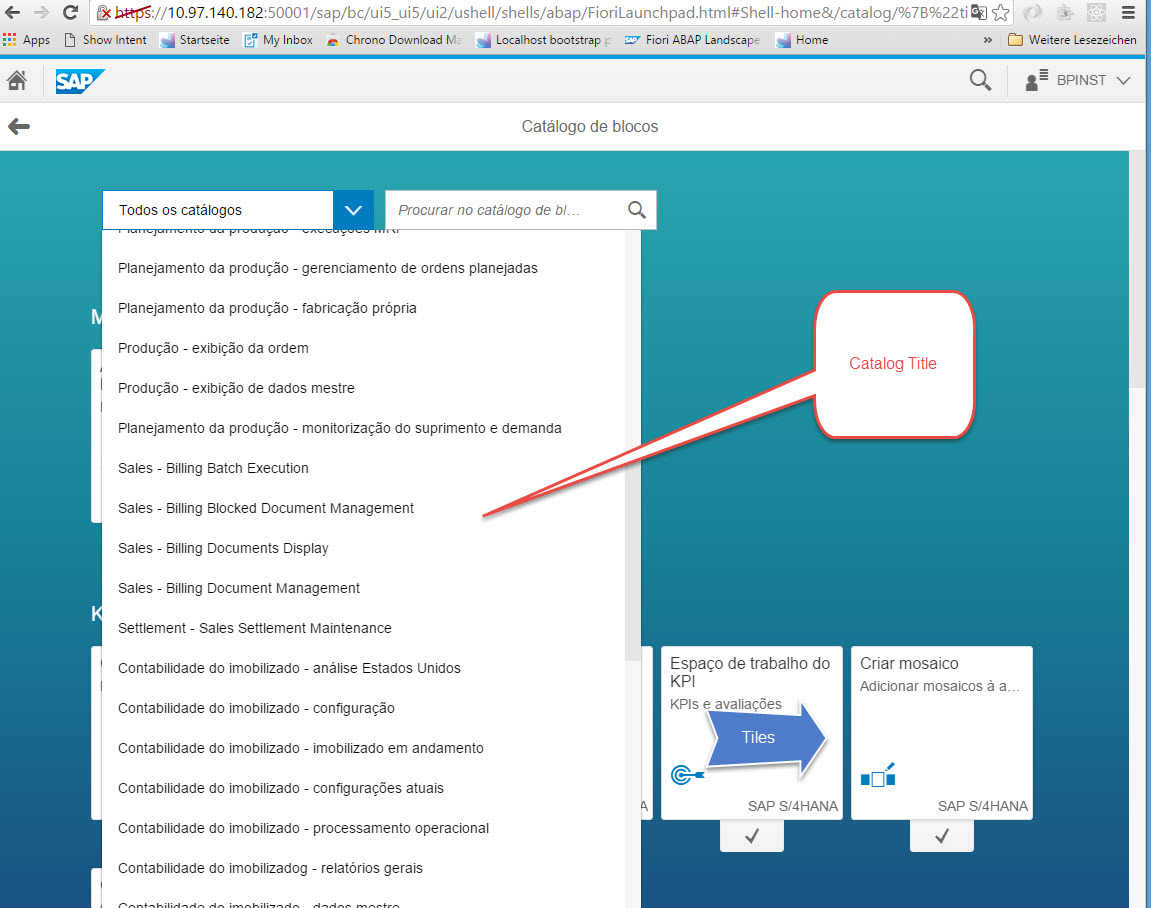
Catalogs, Groups and Tiles
are part of the Business content and defined with the Fiori Launchpad Designer. (FLPD).
Corresponding texts can be found in the Fiori Launchpad designer.
There are three ways described below:
- Identifying from FLPD
- Identifying from PageSet Request of FLP
- Identifying using /UI2/FLC
Identifying from FLPD
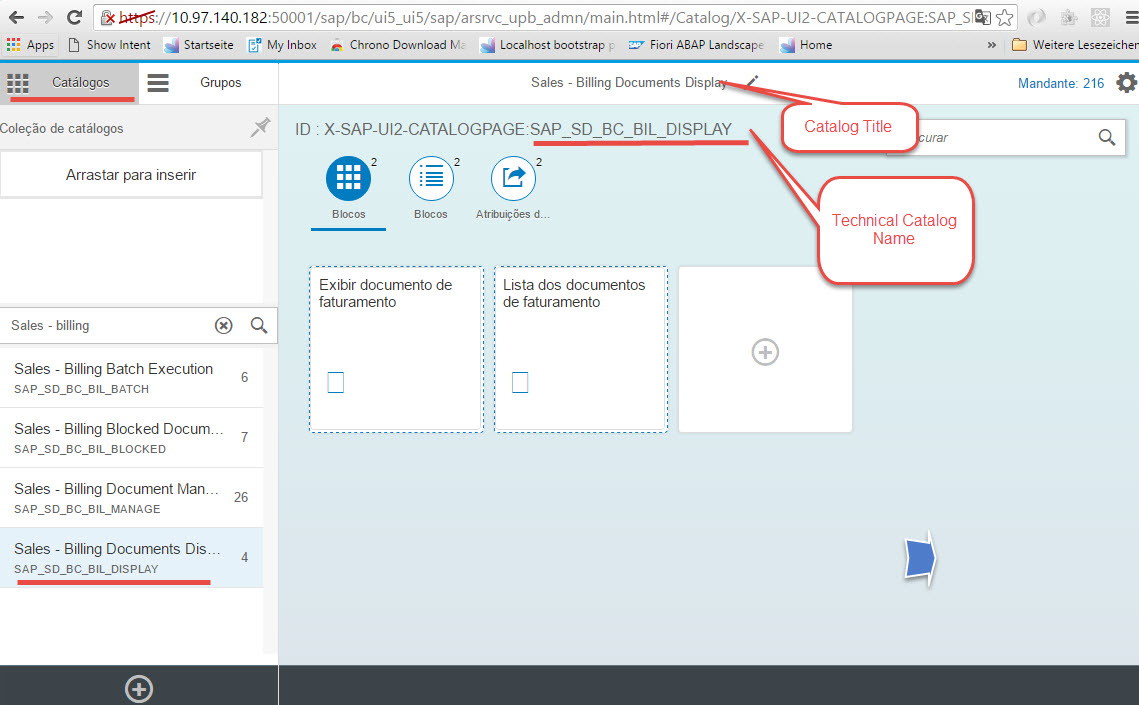
one can use the FLPD to determine the technical key (e.g. Catalogname, groupname) containing the entry.
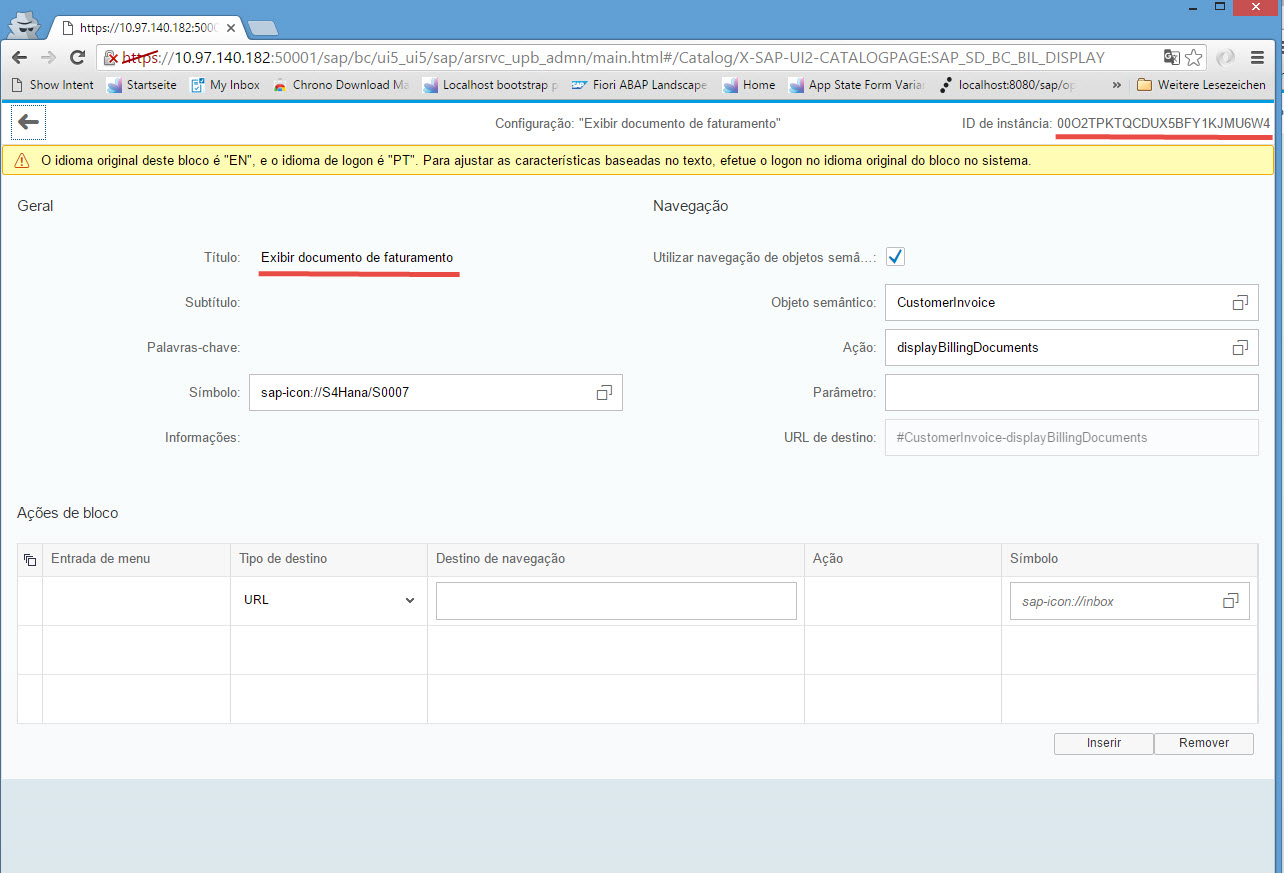
The following documentation describes how to obtain the translation key from the technical key. .
Translating Tiles, Catalogs, and Groups in the Customizing Layer - SAP Fiori Launchpad - SAP Library
Identifying text from PageSet Request
If one does not have access to the Fiori Launchpad designer, the technical key can be determined by inspecting the Pageset request as described below for a group title:
presume we have to identify the technical group name of the group tile "Operação diária":
Opening the developer tools (F12), refresh page(Press F5), on the network tab filter for "Pageset".
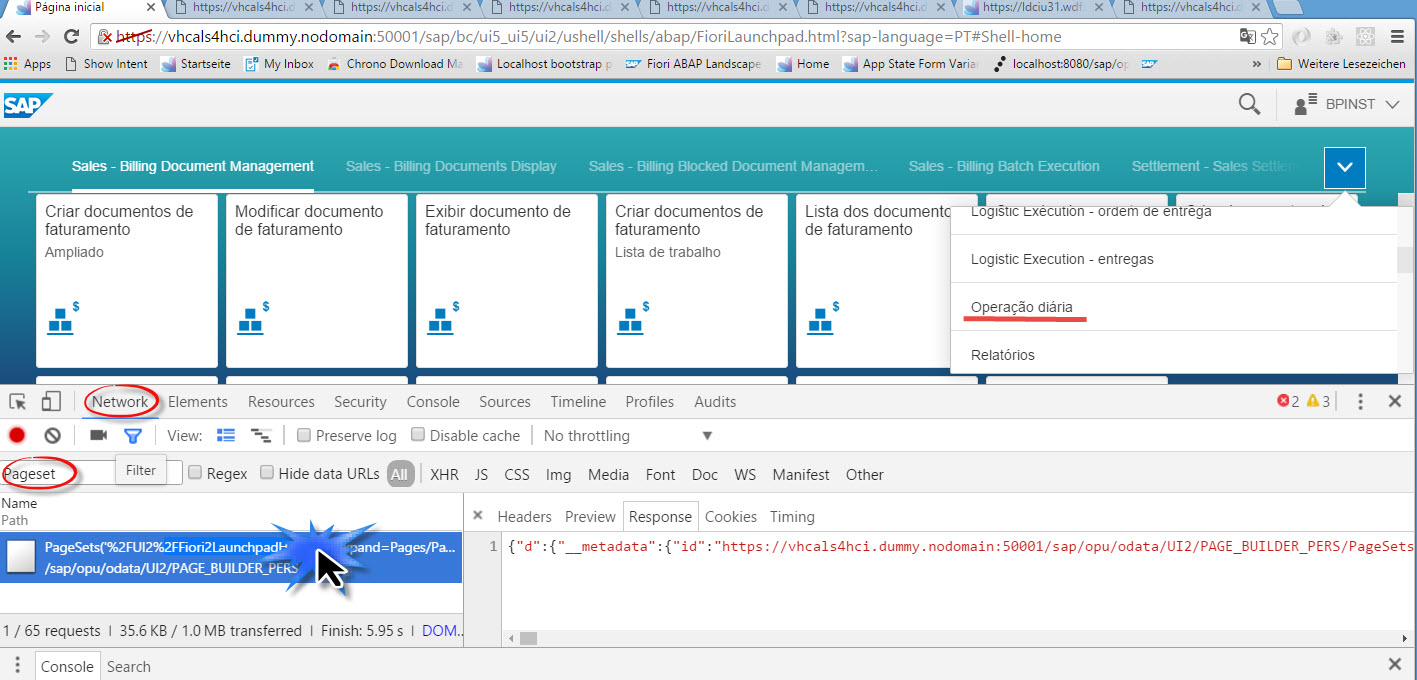
Double click on the pageset request to open it in it's own tab.
then search in this content for the text:
In the vincinity you will find the technical group name:
SAP_SFIN_BCG_CR_DAILY.
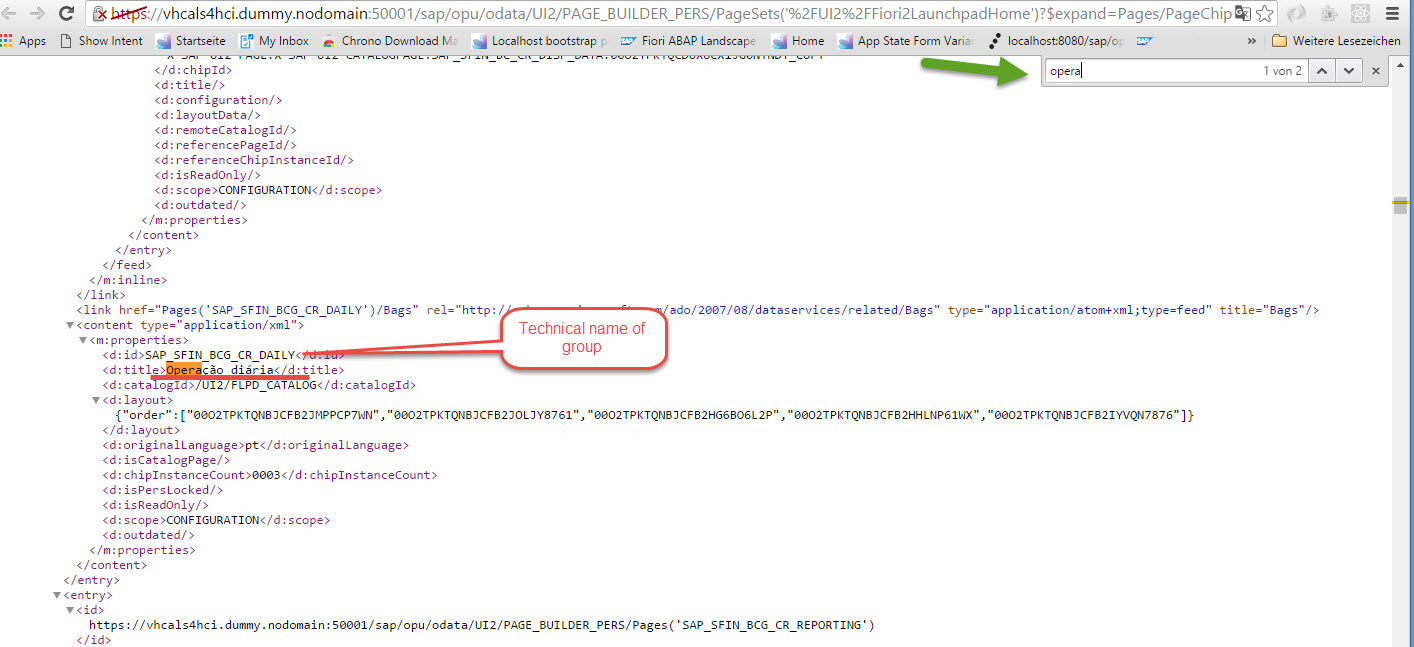
Given the technical key, use
Translating Tiles, Catalogs, and Groups in the Customizing Layer - SAP Fiori Launchpad - SAP Library
to determine the technical translation key.
Note: The actual response of the pageset request is compact. You may use an extension like JSONView to format the response. Alternatively you can copy it to a text editor of your choice and format.

Identifying Texts using /UI2/FLC or /UI2/FLT
The Fiori Launchpad check tool allows to identify the texts of the Fiori Launchpad.
See below in the Appendix.
Application title
Application Title (UI5)

Identify the App by looking for the respective Component-preload.js request occuring when starting the app the first time. The following blog gives you additional hints http://scn.sap.com/docs/DOC-74096

The application path typically correspoind to the bsp repository name
The frontend application texts and typically exposed via an i18n properties files

Note that you can inspect this content:

In newer releases ( UI5 1.38+ ), the application title itself may also be part of the manifest.json request if retrieved from the lrep. The origin of this text is typically still an i18n file in the bsp repository.
This file can be located in the BSP repository (for Applications) or Mime repository (for ui5 resources /SAP/PUBLIC/BC/UI5/LIBRARIES/VER/1.4x/ ...)
Details on the UI5 translation process can be found here:
Prerequisites for Translating Text Elements - UI Development Toolkit for HTML5 (SAPUI5) - SAP Librar...
Translations in SAPUI5 Application
Application title, WebGUI



In the catalog, select Target Mappings, the proper line ( alternatively you can search in the top right search field for the technical target mapping id.
Then click "configure".

On the targetmapping screen you will find the title text, which is used.

Application texts
This article focuses on Fiori Launchpad content texts.
Texts displayed within application screens depend on the applciation technology.
- WDA /Personas
- Webgui /Personas
- UI5 Applications
Backend UI Technologies (WDA, WebGui, Personas)
WDA and WebGUI texts are maintained on the application backend (Suite system, not the ABAP FES) running the application.
(If personas is used, additional texts may be stored in the Personas repository).
UI5 Applications
Texts display within an application screen are either delived as part of the javascript application.
In e.g. an(* en_US.properties) file as described above.
Some texts like error messages or application data are retrieved from the backend via OData calls and thus part of the Suite system.
If in doubt, analyze the content of the network trace to determine the origin of the actual text.
Appendix: Using /UI2/FLC (/UI2/FLP_CONTCHECK) or /UI2/FLT to identify translation keys for FLP(D) texts
Texts of Catalogs, Groups, Tiles and Targetmappings are stored in the WebDynpro Repository.
With /UI2/FLC texts can be identified and the corresponding text keys determined:
Run the transaction /UI2/FLC (identical to /UI2/FLP_CONTCHECK), with "With Text ID" checked on the appropriate layer.
In newer releases, you can run /UI2/FLT which puts all texts in a single column.

Pick an appropriate ALV Layout displaying the TextID Columns ( 2SAP_TRANS)

Identify the respective catalog or group,
The m:2 column indicates the catalog title is nr 2 in the Main WD Config Key entits.

For tile titles, the Property WD Config Key has to be used:
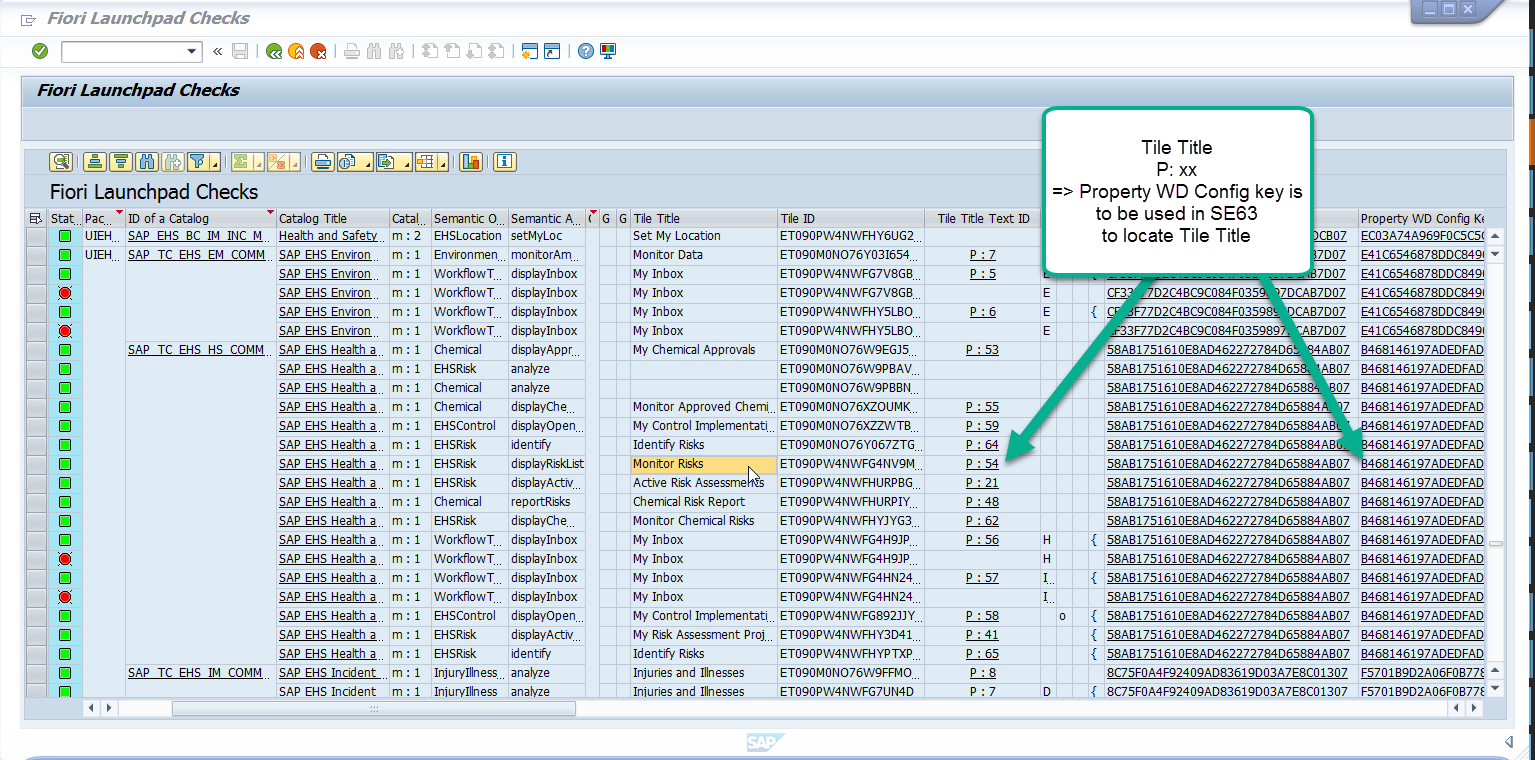

Clicking on the "Catalog Title" columns takes you to a screen list
all (title) texts relevant to this Catalog (Catalog title texts, Tile title, and TM Title texts)

Group and Catalog Titles are stored in the MAIN WD CONFIG KEY. (orange)
Effective Tile and Target Mappings are stored in the Property WD CONFIG KEY! (green)
/UI2/FLT This transaction extends /UI2/FLC and allows selection by text and drilldown into the display for effective texts. It may not be present in older releases.
It allows drilldown from a text to the corresponding definition in case of references (e.g. from a group tile to a catalog or from a reference tile/tm to the actual definition).

Subsequently it allows to drilldown into all relevant texts for a catalog, highlighting the text under investigation.
Note that this catalog exists on both CUST and CONF layer,
with some Tiles/TMs only existing on CUST layer or beeing different on CUST layer.
Note that the Usage ID (Tile or TM ID is unique to a layer!).
But MAIN WD Config Key and Property WD Config Key is the same between the two layers.
Texts from CUSTOMIZNG are stored in table WDY_CONF_USERT2 (!)
Texts from CONFIGURAITON are stored in table WDY_CONFIG_COMPT (!)

Beware, as shown below, Tile and Target Mapping tests are erroneously also redundantly stored in the MAIN WD CONFIG KEY, translating those has no effects.
For details, please refer to https://help.sap.com/doc/saphelp_nw751abap/7.51.0/en-US/d6/c587a7c973479a8bcb7024406fae8e/frameset.h...
Another great blog with less technical details:
https://blogs.sap.com/2015/04/02/translate-on-premised-fiori-launchpad-tiles-in-different-languages-...
- SAP Managed Tags:
- SAP Fiori
You must be a registered user to add a comment. If you've already registered, sign in. Otherwise, register and sign in.
Labels in this area
-
ABAP CDS Views - CDC (Change Data Capture)
2 -
AI
1 -
Analyze Workload Data
1 -
BTP
1 -
Business and IT Integration
2 -
Business application stu
1 -
Business Technology Platform
1 -
Business Trends
1,658 -
Business Trends
105 -
CAP
1 -
cf
1 -
Cloud Foundry
1 -
Confluent
1 -
Customer COE Basics and Fundamentals
1 -
Customer COE Latest and Greatest
3 -
Customer Data Browser app
1 -
Data Analysis Tool
1 -
data migration
1 -
data transfer
1 -
Datasphere
2 -
Event Information
1,400 -
Event Information
70 -
Expert
1 -
Expert Insights
177 -
Expert Insights
336 -
General
1 -
Google cloud
1 -
Google Next'24
1 -
GraphQL
1 -
Kafka
1 -
Life at SAP
780 -
Life at SAP
14 -
Migrate your Data App
1 -
MTA
1 -
Network Performance Analysis
1 -
NodeJS
1 -
PDF
1 -
POC
1 -
Product Updates
4,575 -
Product Updates
378 -
Replication Flow
1 -
REST API
1 -
RisewithSAP
1 -
SAP BTP
1 -
SAP BTP Cloud Foundry
1 -
SAP Cloud ALM
1 -
SAP Cloud Application Programming Model
1 -
SAP Datasphere
2 -
SAP S4HANA Cloud
1 -
SAP S4HANA Migration Cockpit
1 -
Technology Updates
6,872 -
Technology Updates
468 -
Workload Fluctuations
1
Related Content
- Magic Numbers : A Solution to Foreign Characters in SAP CPI in Technology Blogs by Members
- Workload Analysis for HANA Platform Series - 1. Define and Understand the Workload Pattern in Technology Blogs by SAP
- Boosting Benchmarking for Reliable Business AI in Technology Blogs by SAP
- Augmenting SAP BTP Use Cases with AI Foundation: A Deep Dive into the Generative AI Hub in Technology Blogs by SAP
- Building Resilient Applications using SAP Cloud Application Programming Model (SAP CAP) in Technology Blogs by SAP
Top kudoed authors
| User | Count |
|---|---|
| 18 | |
| 12 | |
| 10 | |
| 8 | |
| 7 | |
| 6 | |
| 6 | |
| 6 | |
| 6 | |
| 6 |